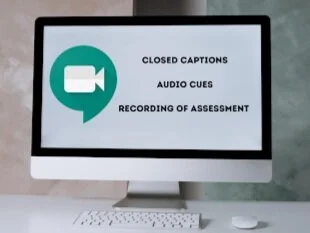Online DSA Assessments, UDL and Equity
Image: Assessor working
We hope you’ve been keeping safe and well working from home. Equity in tech has been an issue at the forefront of education since the COVID pandemic. Since DSA assessments have moved online too, we wanted to share a few bits and pieces about how you can get the most out of your online assessments and how you can promote equity in educational technology.
Image: Two people on a video call
We’ve heard that diagnostic assessments have been extended for September, so we want to share how you can get the most out of Present Pal by incorporating UDL principles into your assessments.In many ways, remote assessments have improved equity and accessibility, especially for DSA students who have physical disabilities and may require more time and effort to get to an assessment centre. Many centres that have been facilitating DSA assessments online pre-COVID, such as those in more rural areas of the country, say that it frees up a lot of time for the assessors as well as providing greater autonomy and flexibility for students.
Universal Design for Learning can be easier online because "there are many different digital tools that can easily be built into the framework of the course that may be harder to integrate in a face-to-face setting.” @PaulDarvasi https://t.co/2jaEct9wQq
— MindShift (@MindShiftKQED) August 23, 2020
How can assessors promote equity in their meetings?
It’s worth bearing in mind that, when carrying out assessments for DSA students, they may have multiple disabilities. Utilising Universal Design for Learning (UDL) principles in your assessments can make a huge difference to how all students understand your content. It means that the content can be used interchangeably for everyone, regardless of ability. The framework below outlines both the ways in which you can incorporate this as well as the outcome for the receiver of your content.
As you can see, solutions such as captioning all your video calls and materials, and perhaps even sharing resources with additional sign language translation as standard, can be a great way to level the playing field without any student feeling singled out or stigmatised.
Could remote assessments be the new normal?
Mark Ross, Disability Support Co-ordinator at the University of the Highlands and Islands (UHI), says that a more technology-driven approach is viable as the norm. He shares: ‘Our ability to deliver needs assessments online (where appropriate) enables us to provide equivalence of the student experience. We apply the same quality criteria regardless of how a needs assessment is delivered.’ We’re keen to promote the same approach at Present Pal, making sure that the quality of the app isn’t compromised by a move to online presenting.
By demonstrating that Present Pal can be used from anywhere, and in conjunction with any device with the ability to run PowerPoint, assessors can show how it benefits students without needing to be there in person. For more info on this, our DSA expert Luke is on hand to help.
What does UDL look like in practice?
The director of student access at Adelphi University in New York, Brian Flatley has tried to adjust the way the university supports students by incorporating UDL principles. He outlines that accommodations haven’t necessarily changed since the move to remote learning, but the method of supporting students has had to adapt. Specifically, he cites the use of closed captions and transcriptions for online lectures, software that takes notes from audio recordings, and technology that describes graphics, charts and other elements to people with visual impairments.
Putting this into context with the Present Pal app, if you recommend the software or a student requests it, you can incorporate the use of audio cues and emphasise the use of the safety net feature, where students can add an extra window of text or an image to jog their memory or to help them describe the image as a way of making their point. Rehearsal cues is another great tool for people with visual impairments to cement their knowledge, equally you can incorporate its use in your demonstration by using Present Pal as part of the call too.
Image: Computer monitor with accessibility tips
How can we help?
Image: Present Pal add-in graphic
Keeping it simple is key for us, we want to empower students by showing that a simple solution really can make all the difference. Even though extra anxiety can be caused by having to present over video call, we don’t want students’ presentations to suffer.
We really appreciate the belief that DSA assessors have in accessible solutions for learning, we wanted to share that just because we’ve moved online for a bit, it doesn’t mean Present Pal is unusable either. On the contrary, it could enhance the equity of assessments and students presentations beyond their DSA meetings. More than that though, we wanted to make sure this provided you with some accessible materials to use in your assessment too.
We’ll be sure to keep you updated with more tips for remote assessment in future. In the meantime, if you’ve got any more questions about the app, we’ve set up a brand new support hub dedicated to Assessors. We’re here to support you, and our expert DSA manager Luke is on hand to answer any questions; you can even book a webinar with him. We hope you enjoyed reading these tips and tricks and learning a bit more about UDL. Stay safe folks!





